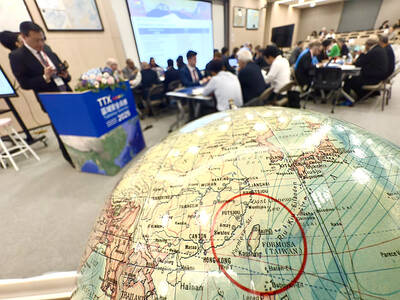For Taiwanese, ramen is one of the dishes that most represents Japan; for Japanese, its origins are in China. Then there is “Taiwan ramen,” which can only be found in Japan, but not in Taiwan.
It is almost impossible to reach a consensus on the origin of any dish, but a brief look at its history might be helpful.
Not many people who are not Japanese question whether ramen is really Japanese.

Photo: Reuters
Yet think about it — ramen is often unctuous and rich, unlike most other must-try Japanese foods familiar to foreign visitors to the country, such as sushi and soba noodles.
According to Kojien, one of the most authoritative Japanese dictionaries, ramen is “soup noodles made in Chinese style.”
It is also called “Shina (支那) noodles or Chinese noodles” — Shina being an archaic Japanese name for China.
The etymology of the term “ramen,” usually written in syllabic hiragana in Japan, is likely the Chinese term “ra men” — written as two Chinese characters meaning “pull” and “noodles” respectively, Japanese food culture academic Okada Tetsu says in his book Ramen’s Birth.
The Nippon Broadcasting System radio network has said that during the Meiji era from 1868 to 1912, Kanichi Ozaki opened a Chinese restaurant called Rairaiken in Yokohama’s Chinatown, providing popular dishes such as Shina noodles made by the Chinese chefs he hired.
Ramen was created in Japan by Chinese chefs and went on to have a unique life journey, Nippon Broadcasting has said.
Tetsu believes that similar noodle dishes were created and sold in many places in Japan during the same period, but the term ramen might have become more widely used during the Taisho era that followed.
What about “Taiwan ramen”?
The “China Taiwan Restaurant Misen” in the central Japanese city of Nagoya, Aichi Prefecture, is generally acknowledged to be where Taiwan ramen originated.
Taiwan-born founder Kuo Ming-yu (郭明優) took inspiration from Taiwan’s danzimian (擔仔麵, “peddler’s noodles”) and gave the dish “a super spicy” makeover, naming it after his birthplace, the restaurant says on its Web site.
Starting as a staff meal, the spicy ramen was added to the menu after gaining approval from regular customers and suddenly became famous during the “super spicy boom” in the late 1980s, it says.
“If the dish was designed for customers from the beginning, I think we would have come up with a cooler name,” third-generation owner Kuoh Sing-chih (郭幸治) said.
Other restaurants in Nagoya wanted to cash in on the ramen so many began selling the popular dish, which regularly appears in rankings of “most-loved Nagoya cuisine” along with miso-flavored deep-fried pork chops and grilled eel rice bowl.
The original restaurant now has three branches in Nagoya, but Kuo Ming-yu’s four brothers and sisters opened independent branches and are said to have developed their own flavors and customer bases.
There are now 16 branches in total, including a few outside Aichi Prefecture in Tokyo and Osaka.
So, what is Taiwan ramen exactly?
Misen puts spicy minced meat, Chinese chives and bean sprouts on top of slightly thick noodles, then adds soup made with chicken bones.
The soul of the dish is, of course, chili pepper, the restaurant says.
The recipe is only faintly reminiscent of Taiwan’s traditional danzimian, which features a shrimp-based soup, shrimp and minced meat that is not spicy.
Tear-inducing spicy minced meat made with lots of garlic and chili is actually rarely seen in Taiwan.
“The spiciness of Taiwanese ramen is unusual. Take a sip of the soup and pause for a few seconds. The strong spiciness will explode in your mouth. If you are not careful, you might choke,” Japanese journalist Nojima Tsuyoshi said.
However, if you are not a fan of spicy food, you can order “Taiwan ramen American,” but if you are looking for a punch of heat, order “Taiwan ramen Italian.” The humble noodle dish really has a globalized naming system.
It is not too difficult to decipher the menu. Think about coffee. As the Americano is a diluted espresso shot, “Taiwan ramen American” is a less spicy version than the regular one, as more soup has been added, while “Taiwan ramen Italian” contains double the amount of chili pepper.
Those who are unable to eat in or have a constant craving for the noodles can order take-home ramen kits and the spicy minced meat, which are sold separately.
Several ramen products labeled as “Nagoya specialty — Taiwan ramen” can also be found in supermarkets as ramen kits and instant ramen in packs or in cups. The name more often than not signals the inclusion of spicy minced meat or, at the very least, the flavor of it.
In 2021, the long-running TV show Himitsu no Kenmin Show (Secret Citizen Show) produced by Japan’s Yomiuri Telecasting Corp aired a special feature on the “Taiwan boom” in Nagoya.
In addition to Taiwan ramen, Taiwan stir-fried noodles, Taiwan rice, Taiwan curry, Taiwan meat skewers, Taiwan cold noodles, Taiwan pasta and Taiwan rice balls have all become part of the fad.
They all include spicy minced meat — enough reason to bear the name Taiwan and become popular.
“People in Nagoya are attracted to anything Taiwan,” which is almost a spontaneous “cell reaction,” a local told the program.
The addition of spicy minced meat is “a guarantee of deliciousness,” regardless of the dish underneath, others said.
Unlike many food trends, the Taiwan boom is not a passing fad as the restaurants the program introduced more than two years ago are still doing well after the COVID-19 pandemic.
Among them is Menya Hanabi, where founder and chef Naoto Niiyama took inspiration from Taiwan ramen and created Taiwan mazesoba, a brothless ramen, and then applied the spicy minced meat magic to curry and opened a new restaurant called Original Taiwan Curry.
Menya Hanabi expanded to the US in 2019 with a new branch in Los Angeles, where the name of the dish was changed to “Nagoya mazesoba.”
If Taiwan ramen was imported to Taiwan, “Nagoya ramen” might be a more suitable name for the dish considering Taiwanese’s love of Japanese food and restaurants.
While purists might disapprove of the misnomer and those who come to Taiwan to track down “authentic” Taiwan ramen might be disappointed, there is never anything wrong with creating delicious food.

DEFENSE: The National Security Bureau promised to expand communication and intelligence cooperation with global partners and enhance its strategic analytical skills China has not only increased military exercises and “gray zone” tactics against Taiwan this year, but also continues to recruit military personnel for espionage, the National Security Bureau (NSB) said yesterday in a report to the Legislative Yuan. The bureau submitted the report ahead of NSB Director-General Tsai Ming-yen’s (蔡明彥) appearance before the Foreign and National Defense Committee today. Last year, the Chinese People’s Liberation Army (PLA) conducted “Joint Sword-2024A and B” military exercises targeting Taiwan and carried out 40 combat readiness patrols, the bureau said. In addition, Chinese military aircraft entered Taiwan’s airspace 3,070 times last year, up about

The Overseas Community Affairs Council (OCAC) yesterday announced a fundraising campaign to support survivors of the magnitude 7.7 earthquake that struck Myanmar on March 28, with two prayer events scheduled in Taipei and Taichung later this week. “While initial rescue operations have concluded [in Myanmar], many survivors are now facing increasingly difficult living conditions,” OCAC Minister Hsu Chia-ching (徐佳青) told a news conference in Taipei. The fundraising campaign, which runs through May 31, is focused on supporting the reconstruction of damaged overseas compatriot schools, assisting students from Myanmar in Taiwan, and providing essential items, such as drinking water, food and medical supplies,

STRICTER ENFORCEMENT: Taipei authorities warned against drunk cycling after a sharp rise in riding under the influence, urging greater public awareness of its illegality Taipei authorities have issued a public warning urging people not to ride bicycles after consuming alcohol, following a sharp rise in riding under the influence (DUI) cases involving bicycles. Five hundred and seven people were charged with DUI last year while riding YouBikes, personal bicycles, or other self-propelled two-wheelers — a fourfold increase from the previous year, data released by the Taipei Police Department’s Traffic Division showed. Of these, 33 cases were considered severe enough to be prosecuted under “offenses against public safety,” the data showed. Under the Road Traffic Management and Penalty Act (道路交通管理處罰條例), bicycles — including YouBikes and other

A magnitude 5.8 earthquake struck Yilan County at 9:53am today, with no immediate reports of damage. The quake had a depth of 72.4km and was centered 15.5km south-southeast of Yilan County Hall in Suao Township (蘇澳), the Central Weather Administration said. Intensities of 3 were felt in parts of New Taipei City, Taoyuan, Taichung, Hsinchu County, Hualien County, Nantou County, Changhua County and Yilan County, it said. The greatest intensity of 4 was felt in Yilan's Wuta (武塔) and Taroko National Park in Hualien County, the agency said. Other regions in northern, central and eastern Taiwan registered intensities of 2, it added. Apparent shaking was